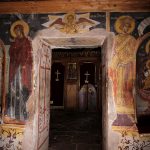The ‘Passing Of The Baton’ To Vlachia And Moldavia
Starting from about the beginning of the 16th century and for the two following ones, the places of the Serbian leaders and nobles who supported the Monastery were taken over by the leaders of Vlachia and Moldavia (present-day Romania). Already in 1501, an annual monetary contribution to the Monastery by a noble family of Kraiovas in Vlachia had been established, while during the 16th century, Vlachian leaders built the tower at the harbour of the Monastery, and in 1521, the Vlachian leader Neagkoe Basarab financed the tower of the monastery compound. Just prior to 1612, the Zitianos Monastery in Vlachia (near Kraiovas) was transferred to the Monastery, along with its metochi, the skete Tsioutoura. In 1664, the St Pavlos Monastery acquired the monastery Ascension of the Saviour-Todireni (written as Theodoreni in Greek sources) as a methochi through a gift of Myron Konstantinos, the Commander of the Guards in Chotin, Moldavia (present day Khotyn, Ukraine). Around the middle of the 18th century, the Monastery acquired the church of St Dimitrios in Galatsi. The Monastery managed to retain the three properties, even increasing their productivity, until the confiscation of all the Athonite properties by the Romanian leader Alexandros Kouza in 1863.
As regards artefacts, the three despotic icons which decorate the icon screen of the old cathedral, all of which date to the second half of the 16th century, were gifts of the Moldavian leader Petros of Cholou (1574-1587). The continuation of the Serbian and Romanian gifts during the Ottoman period are evidenced by two other important works at the Monastery: The fresco painting of the central nave of the old cathedral, and the repair of the west wing between 1690 and 1708.
In addition to the Serbian and Romanian leaders, the Monastery also had contacts with Russian officials. The main figure responsible for this connection was the St Pavlos monk and former Bishop of Melitinis, Anatolios Meles. He visited Russia between 1749-1754 and gave a piece of the Holy Cross, one of the Monastery’s artefacts, to the Empress Elizabeth. In return, she donated 4,000 roubles to the Monastery, and granted permission for three or four monks from the Monastery to visit Russian every five years in order to solicit contributions on behalf of the Monastery.

